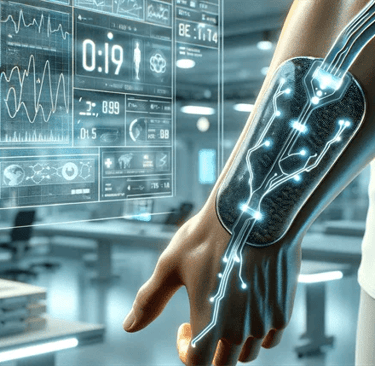items chosen one by one so you have the best option and save money on amazon (Links in articles)
AI-Powered Health Monitors: How Wearable Devices Are Becoming Your Personal Doctor in 2025
What if your smartwatch could predict a heart attack before you felt symptoms? Or your fitness tracker could detect early signs of diabetes — without a single blood test? Welcome to 2025, where AI-powered health monitors are no longer fitness accessories — they’re becoming your personal health assistants, powered by real-time biometrics, machine learning, and medical-grade sensors. These next-gen wearables are redefining preventive care, offering constant monitoring, early diagnosis, and actionable health insights — all from your wrist, finger, or even your shirt. Let’s explore how this revolutionary tech is transforming healthcare, and which AI-powered wearables are already making a difference in people’s lives today.
5/15/20253 min leer


🤖 What Are AI-Powered Health Monitors?
These devices are wearable sensors (like smartwatches, rings, patches, or chest straps) equipped with machine learning algorithms trained to recognize subtle patterns in your physiological data.
They don’t just record — they analyze.
In real time, they can:
Detect abnormal heart rhythms
Monitor blood oxygen, glucose, and hydration
Track stress, sleep, and recovery
Send alerts to you or even your doctor when something’s wrong
And most importantly, they learn from your body over time, becoming more accurate the longer you wear them.
🧬 How They Work
AI-powered health monitors use a combination of:
Biometric sensors (ECG, PPG, accelerometers, temperature, GSR)
Edge AI processors for real-time pattern recognition
Cloud-based health databases for diagnostic models
Health APIs to integrate with medical records or telemedicine apps
Together, these systems can detect early anomalies before they become clinical problems.
For example:
A drop in heart rate variability, combined with poor sleep and elevated skin temperature, might trigger an early warning for infection or burnout.
🔍 What Can They Detect in 2025?
Here are some conditions AI-powered wearables can already help monitor or detect:
Condition / MetricExample Device (2025)Irregular heart rhythms (AFib)Apple Watch Series X, Withings ScanWatch 2Stress & cortisol levelsWhoop 5.0, Fitbit Sense 3Blood glucose (non-invasive)Ultrahuman Ring AIR, Movano Evie RingSleep apnea & snoringOura Ring Gen 4, Withings Sleep AnalyzerDehydration & electrolyte lossGatorade Gx Sweat PatchFertility & menstrual trackingAva Bracelet 4.0, Natural Cycles AI SensorBlood oxygen & respirationGarmin Venu 3, Samsung Galaxy Watch 6 BioActive
These are not just trackers — they’re real-time medical partners.
📈 How AI Elevates Health Monitoring
Traditional wearables showed you raw data.
AI-powered wearables interpret it:
💡 Personalized insights: “Your resting heart rate is trending higher than normal this week. You may be fighting off an illness.”
🧠 Predictive alerts: “You’re showing early signs of overtraining — consider taking a rest day.”
🩺 Clinical-grade signals: “Irregular ECG reading detected. You may want to contact your doctor.”
By combining contextual awareness and historical trends, AI devices go beyond tracking — they enable early intervention.
💼 Real Use Cases in 2025
Remote patient monitoring: Hospitals are using AI wearables to track discharged patients, reducing readmissions.
Athlete optimization: Elite athletes use them to monitor recovery and prevent injury through stress load analytics.
Corporate wellness: Companies provide AI rings and smart patches to reduce burnout and increase productivity.
Chronic condition management: Diabetics and hypertensives use wearables to self-regulate with live biofeedback.
🔐 Are They Safe and Private?
Privacy is a critical concern in 2025. The good news: many top brands follow HIPAA-like data standards, including:
End-to-end encryption
On-device AI processing (data doesn’t leave your body)
Opt-in sharing only (with doctors, not insurers)
Monthly reports for self-monitoring — not marketing
Still, consumers should verify privacy policies and choose brands with transparent data practices.
🛒 Best AI-Powered Health Monitors to Buy in 2025
Here are the most popular and medically validated wearables on Amazon this year:
Ultrahuman Ring AIR – sleek, AI-driven glucose, sleep & metabolism tracker
Withings ScanWatch 2 – hybrid smartwatch with ECG, HRV, sleep apnea detection
Fitbit Sense 3 – AI stress detection, skin temperature, and ECG alerts
Garmin Venu 3 – all-day wellness coach with voice insights and AI-driven HR analytics
Oura Ring Gen 4 – ultra-compact ring with full-spectrum recovery and readiness scoring
👉 Visit the Official AI Health Wearables Store on Amazon
👉 Check out the latest smart health monitors here
🔮 What’s Next? AI + Medicine at Scale
AI-powered wearables are only the beginning.
By 2030, we may see:
FDA-approved diagnostic rings
Implantables for continuous monitoring
Smart clothing with real-time telemetry
AI predicting mental health crises before symptoms appear
Healthcare is shifting from reactive to predictive, and your body will soon be your most powerful interface.
✅ Final Thoughts: The Doctor Is Already on Your Wrist
In 2025, AI wearables are not just fitness tools — they’re life-saving technology. With advanced sensors, machine learning, and medical validation, these devices are bringing healthcare into your daily routine.
Whether you’re an athlete, patient, or simply someone who wants to take control of your health, now is the time to embrace the future of wearable medicine.